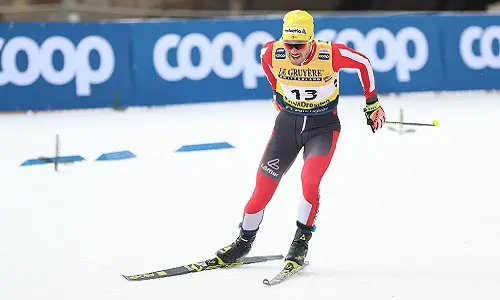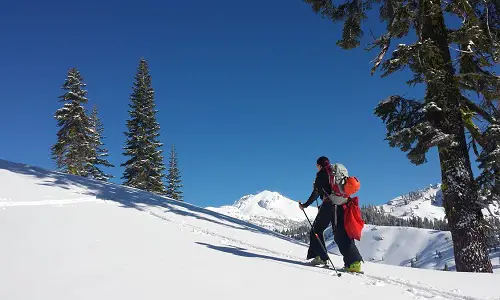Table of Contents
Nordic skiing is not only fun but also a great way to exercise. However, knee pain and knee injuries are quite common for skiers and particularly for cross-country skiers.
Common Causes of Skiing Knee Pain
When you do skiing and especially nordic skiing, your knees are under constant pressure due to the long squat positions.
Furthermore, your leg muscles put pressure on your knees while absorbing the ground force. And if that was not enough, your hips exert pressure on your knees to stay aligned and keep a balance, so you do not fall. As a result, you ski downhill, but your knees take a lot of pressure.
If you have strong knee muscles and have warmed up before hitting the tracks, your knee muscles may be able to withstand all the motion.
It is important to know a little bit about your knee’s anatomy to understand how it functions and how our certain actions result in disrupting this functionality. Our knee is made up of 3 bones: femur, tibia, and fibula. The femur is our thigh bone, the tibia is the shin bone, and fibula is the smaller bone at the outer side of your lower leg. Four ligaments hold this bone together. These are:
- The 2 anterior and posterior ligaments that prevent your knees from hyper flexing and hyperextending (bending too forward or too far back in the wrong direction).
- The 2 collateral ligaments that prevent your knee from moving to extreme sides.
When you ski, you perform repetitive movements involving these ligaments and focusing on your knee muscles. One bad landing or slip can result in a knee injury.

There are quite a few common mistakes which can lead to serious knee injuries when you ski either downhill or nordic:
- Incorrectly landing after a jump when your body weight is drawn towards the back instead of going forward.
- The snowplow position where you point your skis inwards to turn or stop.
- You undergo collision while skiing or fall hitting your knee directly on the ground.
- When you go down a slope, you may throw your lower leg outwards. This may result in your knee getting injured.
These poorly performed techniques could possibly cause some of the conditions below:
1. Patellofemoral Pain Syndrome
Patellofemoral Pain Syndrome is not a new term among cross country skiers. It mainly affects sportsmen such as skiers, cyclists, and runners – those who indulge in activities that involve a lot of repetitive movement of the knees.
In this syndrome, the area around the kneecap is affected in the form of tissue damage, inflammation, or strain. As a result, the skier undergoes pain.
Symptoms
The prominent signs and symptoms of Patellofemoral Pain Syndrome include:
- Shooting or dull pain around the skier’s kneecap.
- The kneecap does not move as it normally does and trying to move it results in more pain.
- When you put a little pressure on your knees or try to flex it, the pain increases.
- When you move your knee or walk, you hear a cracking or snapping sound.
- You may experience slight swelling around your kneecap.
2. Skier’s Knee
Although a large number of athletes have heard about Skier’s Knee (also known as Runner’s Knee) and many of them go through it, there is no exact diagnosis of this condition.
Skier’s knee is quite common among sportsmen and health enthusiasts that do a lot of bending and straightening of their knees. This includes runners, cyclists, cross country skiers, football players, as well as handball players. However, the exact reasons, symptoms, or conditions of all these people who suffer from Skier’s Knee may be different from one another.
This is because Skier’s Knee is rather an umbrella term that covers pain around the knee or kneecap area.
Some doctors believe that Skier’s Knee is caused by a thick band of tissue (known as tractus iliotibialis or the iliotibal band) that lies on the outside of the hip. The iliotibal band is attached to the knee. When a skier bends and straightens his/ her knee too many times, friction is created inside this band and this leads to irritation in bursa, which is a tiny sac filled with fluid. The result is severe pain.
Although no one knows for sure what happens, some doctors dismiss this theory. No matter what the real cause is, one this is for sure – the Skier’s Knee causes knee pain and with the right kind of treatment and care, you can recover from it.
What to Do with Skier’s Knee?
To get rid of the acute pain, you can put ice-packs on the knee, or do some gentle massage around your kneecap. Use an ice pack around your knee for 15 to 20 minutes. Repeat after every two hours. Compression may also help reduce pain.
The most important treatment is to figure out what caused the actual problem and not to repeat it (or overdo it) in the future. You may think about taking help from a trainer that may help you with your posture and load management techniques.
There are instances when a skier goes through Skier’s Knee by either training too much or skiing without proper rest. Cross country skiing is a strenuous activity and your body needs ample amount of rest and sleep.
Elevating your knees can also help reduce the pain and irritation. Do not ignore any kind of prolong or unbearable pain, swelling, and stiffness. Observe your knees for 24 and up to 48 hours if the pain is bearable and improving. If you feel the pain is not completely going away, or there is some increased swelling around your kneecap, it could be because of sprained ligaments of the knees.
How to Prevent Knee Pain When Skiing?
You can prevent knee pain and injuries by warming up before hitting the track. Also, prepare your body for a couple of months with conditioning exercises that focus on your core muscles. Polishing your skiing skills is also crucial to prevent injuries as you can injure your knees by a bad landing, collision, or fall.
Consider the following preventative measures to avoid knee injuries when skiing:
1. Pre-Season Ski Conditioning
One thing many novice skiers (and often experienced ones too) do is that they stay away from all kinds of exercises throughout the year and when winter arrives, they jump into their skis.
This kind of one-sided lifestyle does not prepare the body for any kind of strenuous activities that Nordic skiing offers when winter arrives.
If you do not exercise regularly, you are bound to get tired on the slopes, resulting in shorter skiing experience and more frustration.
But what is more dangerous is the chance of hurting your back and especially the knees after a year-long idle position and posture. To avoid all kinds of injuries, especially your knee injury, you need to indulge in pre-season ski training.
Pre-season conditioning does not mean that you try to ski on grassy slopes. It means you keep your body in shape and your muscles need to be used to what winter will bring in. For this, you need to ideally do a combination of cardio and weight training.
2. Warm-Up
Even if you have been quite regular in hitting the gym for the rest of the year, doing a warmup before you put on your cross country skis is crucial.
Do a bit of stretching followed by a combination of light movements including lunges, arm circles, and lunges, all for about 15 to 20 minutes.
It is hard for your cold muscles to show a hundred percent activity level when directly exposed to an exhausting workout. If you cannot do light exercise, you can go for a walk that moves your muscles and keep the heart pumping.
Stretching increase your mobility and range of motion. Heading towards the snowy hills without a warmup is calling for trouble. For this reason, a pre-ski warmup is highly recommended.
3. Practice
Practice makes a (wo)man perfect, and this holds true in the world of skiing as well. The more you practice your skiing skills, the better are the chances for you to avoid slopping mistakes that lead to knee injuries.
To differentiate between the correct and incorrect skiing posture, it is important to know the difference yourself. So that when you spot someone with a bad skiing technique, you can either help them out (to avoid them from getting injured) or remind yourself not to do that.
In cross country skiing, you must keep your hips above your waist, arms forward, and maintain full control over your body by balancing it.
4. Know How to Fall
All skiers fall, and as weird as it may sound, there is a right way to fall and a wrong way too. The right way to fall will keep your back and knees safe whereas if you fall down the wrong way, you may end up injuring your knees (or other parts of your body) and may even have to say farewell to that season of skiing.
To make sure you fall correctly, you should practice the following:
- Flex your knees while you fall and keep them flexed until you stop sliding. A mistake that skiers often make is to stiffen up their bodies in a straight posture when they are falling.
- In order to protect your face and arms, bring them towards your core while you are falling and sliding.
- Do not attempt to stand up while you are still sliding down as this will increase the chances of injury. Wait for the sliding to finish (by making sure your hands and face are centered towards the core) and then once your body stops sliding, try to regain your control.
If you have sprained your knee muscles, getting treatment sooner is better than later. Once you have done acute care and feel that even after 24 to 48 hours of observation (this includes elevating your knee, resting, and applying ice) the problem is still there, consult a doctor.
Consult a Specialist
In order to prevent knee injuries while Nordic skiing, you must make sure you have the proper skiing gear and know what you are doing. If you are new to skiing, it is better to take classes or accompany your trainer.
If you have sprained your knee muscles, getting treatment sooner is better than later. Once you have done acute care and feel that even after 24 to 48 hours of observation (this includes elevating your knee, resting, and applying ice) the problem is still there, consult a doctor.


